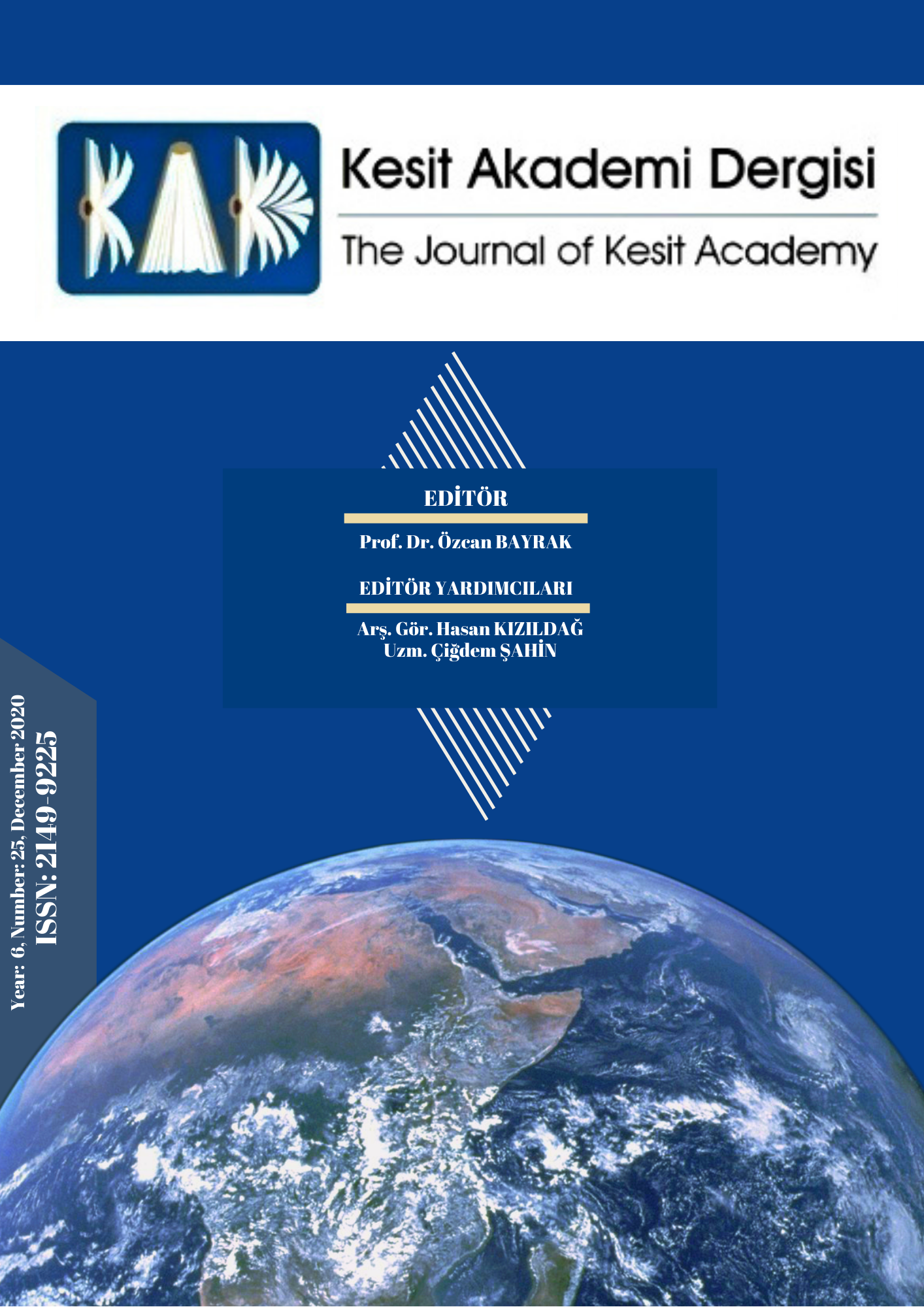Author :
Abstract
Dil ve toplumsal cinsiyet alanında yapılan en son çalışmalar dilin insanlar arasında iletişim kurmayı ve/ya düşüncelerini aktarmayı sağlayan basit bir ortak işaretler sistemi değil, aksine, kadınların yaşam alanlarını sınırlamada ve onların itaatkâr bir hayat sürmelerini sağlamada etkin ve baskın bir rol oynayan önemli bir araç olduğunu kanıtlamıştır. Aslında dil, erkek egemen ideolojilerin inşasını sağlayan ve eril kurallar bağlamında kadınları ‘seçimsiz’ durumlar içine hapseden erkek egemen bir yapıdır. Ancak kadınların kendilerini erkek egemen söylem ve dili tarafından oluştulmuş bu tanımlardan kurtarma; itaatkâr ve ikincil konumlarını değiştirme zamanı gelmiştir. Bu bilgiler doğrultusunda ve post-yapısalcı feminizm kuramlarını temel alarak, bu çalışma, ataerkil ideolojiler ve söylemlerce oluşturulmuş toplumsal cinsiyet normlarının ve rollerinin kadınlarca nasıl yıkalabileceğinin ve yeniden nasıl yaratılabileceğinin olasılıklarını göstermeyi amaçlamaktadır.
Keywords
Abstract
Recent studies on language and gender have proved that language is not simply a system of words or signs shared by a group of people to establish communication and convey messages, but rather it plays an active and dominant role in creating a subjugated and subservient life for women. In fact, it is the man-made language that constructs the patriarchal ideologies imprisoning women into the ‘no-choice choice’ situations, where women are judged against a masculine standard. However, it is high time women stopped defining themselves in accordance with the appropriate behavior and language created by men and changed their submissive and secondary position. Considering those issues and basing its argument on post-structuralist feminist theories, this study aims to manifest the alternative ways for women to subvert and de(con)struct the patriarchally constructed gender norms and roles.
Keywords
- Beal, F. M. (1975). Slave of a Slave No More: Black Women in Struggle. The Black Scholar, 6 (6), 2- 10.
- Black, M. and Coward, R. (1981). Linguistic, Social and Sexual Relations: A Review of Dale Spender’s Man-Made Language, Screen Education. 39, 69-85.
- Bloom, H. (1973). The anxiety of influence: a theory of poetry. New York: Oxford University Press.
- Boswell, J. (1966). The life of Samuel Johnson, LL.D. Vol. I, London: J. M. Dent.
- Butler, J. (1990). Gender trouble: Feminism and the subversion of identity. New York: Routledge.
- Cameron, D. (1995). Verbal hygiene. London: Routledge.
- Daly, M. (1990). Gyn/ecology: the metaethics of radical feminism, Boston: Beacon Press.
- Fetterley, J. (1978). The resisting reader: A feminist approach to American fiction. USA: Bloomington.
- Frank, F. W., & Treichler, P. A. (1989). Language, gender, and professional writing: Theoretical ap- proaches and guidelines for nonsexist usage. New York: The Modern Language Association of America.
- Franklin, R. W. (1998). The poems of Emily Dickinson: Reading edition. USA: The Belknap Press of Harvard University Press.
- Gilbert, S. M. and Gubar, S. (1984). The madwoman in the attic: The woman writer and the nine- teenth-century literary imagination. London: Yale University Press.
- -------------------. (1985). Sexual linguistics: Gender, language, sexuality. New Literary History, 16 (3), 515-543.
- Goodreads. (2011). Quotable Quote, A quote by Winston S. Churchill,(Viewed:19.04.2014, http://www.goodreads.com/quotes/421900-a-good-speech-should-be-like-a-woman-sskirt-long)
- Henley, N. (1987). This new species that seeks a new language: On sexism in language and lan- guage change. Women and Language in Transition. New York: State University of New York Press, 3-25.
- Kolodyny, A. (1976). Literary criticism, Signs 2, 435-460.
- Lakoff, G., & Johnson, M. (1980). Metaphors we live by. Chicago: University of Chicago Press.
- Lakoff, R. (2004). Language and woman’s place: Text and commentaries. (Mary Bucholtz, Ed.). New York: Oxford University Press.
- Lanser, S. S. and Beck, E.T. (1979). [Why] are there no great women critics?: And what differ- ence does it make? The Prism of Sex: Essays in the Sociology of Knowledge. Madison: University of Wisconsin Press.
- Maltz, D., & Borker, R. (1982). A cultural approach to male-female miscommunication. J. Gumperz (Ed.) in Language and Social Identity. (pp. 196-216). Cambridge: Cambridge University Press.
- Martin, E. (1991). The egg and the sperm: How science has constructed a romance based on stereotypical male-female roles. Signs: Journal of Women in Culture and Society, 16, 485501.
- Miller, C. and Swift, K. (1976), Words and women. Doubleday, NY: Anchor Press.
- Morgan, R. (1977). Going too far: The personal chronicle of feminist. New York: Virginia University.
- Ortony, A. (1993). Metaphor and thought. UK: Cambridge University Press.
- Rich, A. (2004). The moment of change. USA: Praeger Publishers.
- Said, E. W. (2002). Criticism and society. London: New Left Books.
- Schatten, G. and Schatten, H. (1984). The energetic egg. Medical World News 23, 51-53.
- Shakespeare, W. (2007). Julius Ceaser, in Shakespeare Library Classics, Filiquarian Publishing, LLC.
- -------------------. (2007). King Lear, in Shakespeare Library Classics, Filiquarian Publishing, LLC.
- -------------------. (2007). The merry wives of Windsor in Shakespeare Library Classics, Filiquarian Pub- lishing, LLC.
- Sheldon, A. (1990). Kings are royaler than queens: Language and socialization. Young Children, 45 (2), 3-11.
- Showalter, E. (1977). A literature of their own: british women novelists from Bronte to Lessing. UK: Princeton University.
- -------------------. (1979). Toward a feminist poetics, women’s writing and writing about women. Lon- don: Groom Helm.
- -------------------. (1981). Feminist criticism in the wilderness. Critical Inquiry, 8 (2), 179-205.
- Spacks, P. M. (1976). The female imagination: A literary and pscyhological investigation of women’s writing. London: Allen & Unwin.
- Spender, D. (1980). Man made language. London: Routledge.
- Sterling, A. F. (2000). Sexing the body: Gender politics and the construction of sexuality. New York: Basic Books.
- Wittig, M. (1973). Les guérillères. Donald Le Vay (Trans.). New York: Norton.
- Wood, J. (1997). Gendered lives: Communication, gender, and culture (2nd ed.). Belmont: Wadsworth.
- Woolf, V. (1979). Women and fiction. Michele Barrett (Ed.). in Women and Writing (pp. 48 – 191). New York: Harcourt.





